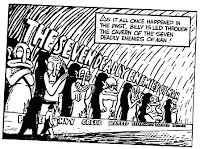Most of the signals running along the neurons in your brain and spinal cord and in the tips of your fingers and the bottom of your bum are started because sodium rushes inside those neurons. The sodium gets in through voltage gated sodium channels. If your voltage gated sodium channels can’t open, neurons can’t fire, and you are done for.
Last week, I talked about a new paper that showed how a little worm, C. elegans, gets along without the sodium channels that we absolutely need. Gao and Zheng claim that the roundworm uses calcium, instead of sodium, to drive action potentials.
There are two ways to make a neural signaling system without using sodium. One is to use another ion, like calcium, to start an action potential. A second way is not to use action potentials at all, but to use graded signals (non-spiking neurons). Graded signals fade as they travel, so they tend not to be the norm.
Something I didn’t emphasize enough in my previous write-up was that Gao and Zheng were working on the muscles, not the neurons. Do the neurons also use calcium to make spikes?
If you were a regular reader with a phenomenal memory, you might dredge out of your memory that about a year and a half ago, I wrote about another C. elegans paper. It claimed that this worm’s motor neurons didn’t generate action potentials at all.
Gao and Zheng, in this newer paper, do several things. First, they are able to replicate the previous finding. They show that the motor neurons are stimulated by increasing amounts of light (described in more detail in the earlier post), there is a graded flow of ions into the muscle. But, these small potentials eventually hit a threshold within the muscle cell, which then triggers the calcium-driven action potentials, which cause the muscle to contract.
They’re also able to provide some evidence that there are two classes of these motor neurons: Excitatory motor neurons, which use acetylcholine as their transmitter, and; inhibitory motor neurons, which use GABA as their transmitter.
“Inhibitory motor neurons?”
I learned that some neuroscientists will blow a fuse at this point. Slip a gear. Spit the dummy.
I once gave a presentation where I mentioned inhibitory motor neurons. There were two prominent researchers in the audience who had co-authored two very successful undergraduate neuroscience textbooks. They were caught flat-footed by the idea of inhibitory motor neurons. They had no idea a nervous system could work that way. They believed that there are only excitatory motor neurons. This is true... for skeletal muscles in mammals. Inhibitory motor neurons are common in invertebrates, like arthropods and C. elegans.
It was a powerful reminder to me about how everyone has their blind spots.
Back to the paper. Here’s a little experiment showing that you can block action potentials in the muscles by putting on a little of the suspected neurotransmitter released by the motor neurons.
Gao and Zhen were also able to show that by stimulating neurons know to contain GABA, they were able to see relaxation of the muscles.
Mammals are use sodium-generated spikes in neurons, and those neurons can only excite muscles, which also use sodium to trigger contraction.
The worm has no spikes in its neurons, and those neurons both excite and inhibit the muscle, which use calcium to trigger contraction.
The physiology of the neurons in C. elegans are so different those of mammals that is is almost perverse that the worm has become a model system for neuroscience. But that it is different presents a wonderful opportunity for all neuroscientists to learn to appreciate the diversity of nervous systems.
Not everything works like a mammal.
References
Gao S, Zhen M. 2011. Action potentials drive body wall muscle contractions in Caenorhabditis elegans. Proceedings of the National Academy of Sciences 108(6), 2557-2562. DOI: 10.1073/pnas.1012346108
Liu Q, Hollopeter G, Jorgensen E. 2009. Graded synaptic transmission at the Caenorhabditis elegans neuromuscular junction Proceedings of the National Academy of Sciences 106(26): 10823-10828. DOI: 10.1073/pnas.0903570106
Photo from here.


































